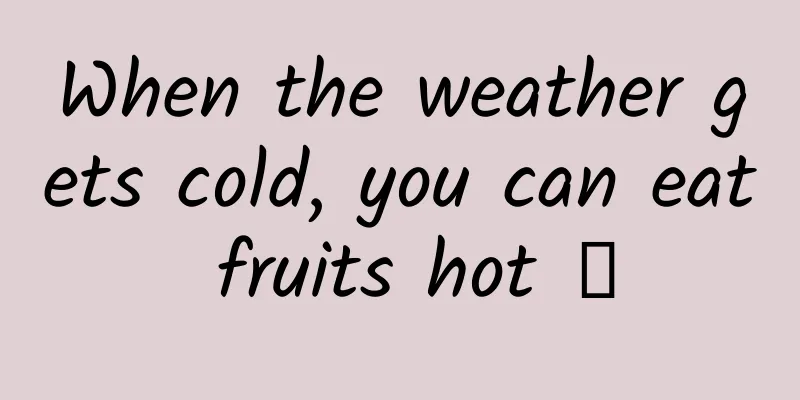When the weather gets cold, you can eat fruits hot →

|
As the weather gets colder, friends who want a balanced diet and love to eat fruit are hesitant when it comes to fruit. They think it’s a bit cold to eat it raw, but they worry about losing nutrition if they eat it hot. In fact, eating fruit hot is not as bad as you think! 01Not all nutrients are afraid of heat Many people worry that eating cooked fruits will lose nutrients. So, what nutrients are rich in fruits? Fruits contain various minerals such as potassium, calcium, magnesium, etc.; vitamins such as vitamin C and carotenoids; "phytochemicals" such as flavonoids and anthocyanins, which are important antioxidants; soluble dietary fibers such as pectin, which can reduce blood sugar, blood lipids and blood cholesterol; insoluble fibers such as lignin can promote intestinal peristalsis and help prevent intestinal cancer. So, are these nutrients afraid of heat? Image source: Pixabay Actually, this is not the case. Not all nutrients in fruits are afraid of heat. For example, fat-soluble substances such as carotene and lycopene are basically not afraid of heating at 100°C, and minerals and dietary fiber will not be lost due to heating. Most of the polyphenolic plant antioxidants can also be retained under boiling conditions. Therefore, eating cooked fruits does not necessarily lose their nutritional value. Moreover, even for those nutrients that are more sensitive to heat, the loss caused by cooking is not as great as you think. The nutrients in fruits that are most afraid of heat are mainly vitamin C and some B vitamins, so usually, after cooking, such as boiling, steaming, microwave and other processing, the loss of these two types of vitamins will be relatively large. But you don't have to worry too much. First of all, most fruits do not contain much B vitamins. Even if they are not lost, they are still very little. They are not our main source of B vitamins. As for vitamin C, which everyone is most concerned about, generally speaking, after cooking, the loss rate of vitamin C in fruits will not exceed 50%. Data from the U.S. Department of Agriculture show that after heat treatment of apples, the loss of vitamin C and B vitamins does not exceed 10%. Some fruits, such as apples, pears, and bananas, contain relatively little vitamin C, and the loss is also minimal. Moreover, loss does not mean that there is no vitamin C at all. Compared with not eating it at all, eating cooked fruits can still obtain most of the nutrients. 02Proper cooking also has benefits Don’t think that cooking will only destroy nutrients, proper cooking also has benefits. Cooking can destroy the plant cell walls of fruits and soften the fruits, making them easier to digest for people with poor digestive function. Moreover, after the plant cell walls are destroyed, some nutrients are easier to dissolve and absorb. Research from Cornell University found that proper cooking of fruits can enhance our absorption of some nutrients. After boiling tomatoes at 88°C for 30 minutes, the researchers found that the content of cis-lycopene, a type of lycopene, increased by 35%. The main reason is that proper heating can destroy the plant cell wall, accelerate the dissolution of lycopene, and help the human body absorb it better. Proper cooking may also increase the antioxidant capacity of fruits. A study found that when tomatoes were steamed at 88°C for 1 minute, 15 minutes, and 30 minutes, the total flavonoids and total phenolic content of tomatoes did not decrease after heat treatment, but increased slightly. The total antioxidant capacity was also found to increase. Lycopene is a red carotenoid, famous for its high content in tomatoes, and also abundant in red fruits such as guava, papaya, and watermelon. In recent years, lycopene has been considered as a more promising antioxidant than vitamins. A German study conducted a survey on 198 men who strictly ate raw fruits and vegetables. The respondents usually ate almost all of their food raw. The researchers measured the lycopene content in their bodies and found that these people had less lycopene in their bodies, with more than 80% of the subjects below the normal level. It can be seen that eating completely raw may not be the best way to eat, but at least eating cooked food is also a good choice. In addition, cooking can also better ensure safety. For example, eating cooked fruits can kill bacteria and microorganisms that may remain on the surface of fruits, and can also inactivate allergens in fruits and reduce the risk of allergies. For example, mangoes and pineapples contain highly active proteases, which can easily cause allergies. If they are cooked, heating will inactivate the protease, so even people with allergies can eat them with confidence. 03 Eat raw or cooked? First of all, eat more! Numerous studies have proven that eating more fruit is good for health. Harvard University conducted a 14-year dietary follow-up survey on 110,000 people and found that those who ate more fruit every day had a significantly lower incidence of cardiovascular disease than those who ate less fruit. At the same time, eating more fruit can also help reduce the incidence of chronic diseases such as stroke and gout, and can also reduce the incidence and mortality of cancer, and has a positive effect on preventing diabetes and obesity. Given that fruits have so many benefits for our health, nutrition guidelines and nutrition experts from all over the world recommend eating more fruits. The latest American dietary guidelines recommend that adult men eat 2 cups of fruit per day, while adult women eat 1.5 cups of fruit per day. my country's Resident Dietary Pagoda recommends that adults eat 200-400 grams of fruit per day. "Cup" is an informal unit of measurement that is very common in European and American countries. Because it is informal, there is no unified international standard. The smallest is about 200 ml and the largest can be up to 284 ml. A cup in Commonwealth countries is 250 ml, and a cup in the United States is customarily half a pint (also a unit of volume, mainly used in the United Kingdom, the United States and Ireland, with different standards in the United Kingdom and the United States), which is 237 ml, but the legal definition used in food labels is 240 ml. A cup in Japan is 200 ml. Image source: Pixabay However, the actual situation is far from the recommended amount. The fruit consumption of residents in various countries around the world is still relatively low, far from the recommended amount. According to surveys, the per capita fruit consumption of Chinese residents does not exceed 100 grams. Therefore, the problem we are facing now is more about not eating enough fruit. Finding a way to get everyone to eat the recommended amount of fruit is our current major problem. Aside from economic and social factors, the cold weather does become a barrier for some people to eat fruit. Since eating cold fruit can make people feel uncomfortable in the stomach, isn't it a better way to eat it cooked? Compared with the loss of nutrition in cooking, eating cooked fruit can help people eat more fruit, which is good for health. So, whether you eat it raw or cooked, you must first eat enough of the recommended amount of nutrition. As for which method to choose, it depends on which method you find more comfortable and convenient. It should be noted that eating more fruit here is based on the premise that the total energy remains unchanged, and fruit is used to replace some other foods. That is to say, the total energy intake of each day should remain unchanged. While eating more fruit, the intake of other foods, such as meat, starchy staple foods, fat, etc., should be appropriately reduced. If other foods are not reduced, but only the amount of fruit is increased, the total energy intake will be too high, increasing the risk of obesity and may also be detrimental to health. Source: Chongqing Science and Technology Museum Author: Ruan Guangfeng, Master of Nutrition and Food Safety Audit expert: Li Chunli Statement: Except for original content and special notes, some pictures are from the Internet. They are not for commercial purposes and are only used as popular science materials. The copyright belongs to the original authors. If there is any infringement, please contact us to delete them. |
<<: How does “nuclear” produce “steam”?
Recommend
How do ocean giants find tiny prey?
© The Marine Mammal Center Leviathan Press: The N...
Meizu M3s mobile phone review: Is it worth upgrading to fingerprint + metal shell for 100 yuan?
Two months after the release of the Meizu Blue 3,...
Trivia | Can you continue a dream that you haven’t finished the next day?
Control material method. The most common material...
A war about retention rate!
Since I started my public account, people have be...
Is coughing up phlegm a way for the body to detoxify? Different colors of phlegm indicate different diseases!
It’s autumn now, the weather is cool, the moon is...
Chat Weapon Arsenal, teach you how to make him/her talk to you endlessly 1PDF
Chat Weapon Arsenal,, teach you how to make him/h...
Whatever you talk about, we will push you the same thing! How to prevent mobile apps from "eavesdropping"?
"When I talked to my friends about wanting t...
QQ Simple Edition, Tencent TIM PC Edition 3.3.5 beta version download: Netdisk supports backup of chat records
IT Home reported on February 7 that recently, Ten...
Apple launches new iPod Touch: starting at 1,495 yuan, is it worth buying?
On July 15, Apple's online store showed that ...
The Road to Godhood - The Core Secret Method to Conquer Ordinary People
The Road to the Gods: A brief introduction to the...
Which is the brightest star in the night sky?
Produced by: Science Popularization China Author:...
Second category e-commerce advertising strategy!
Preface There are two characteristics of the seco...
There are 5 cases of people cured of AIDS in the world. Can the method of conquering AIDS be replicated?
AIDS, the full name of which is "Acquired Im...
The most comprehensive paid membership system analysis
In the well-known AARRR model , the membership sy...









